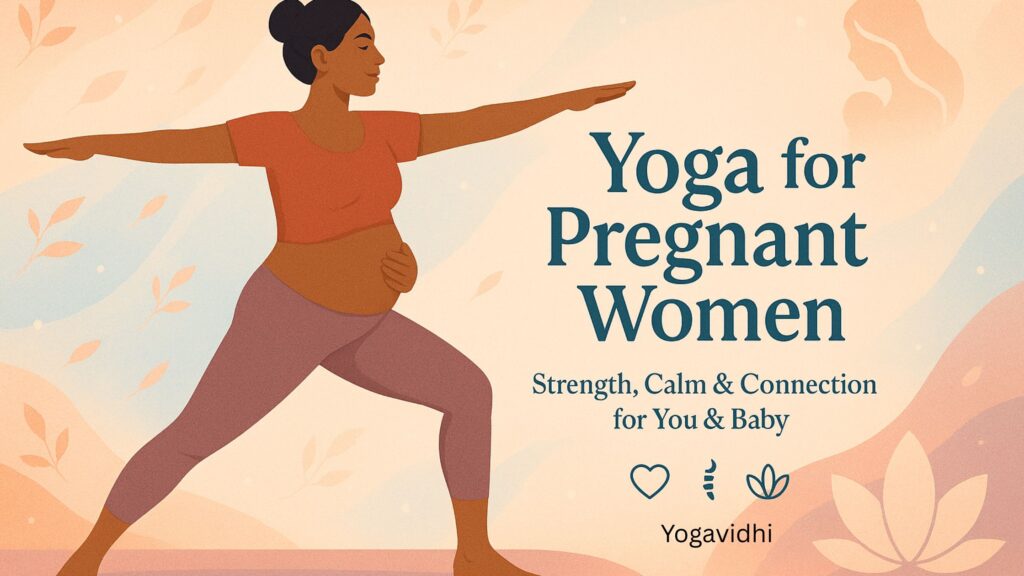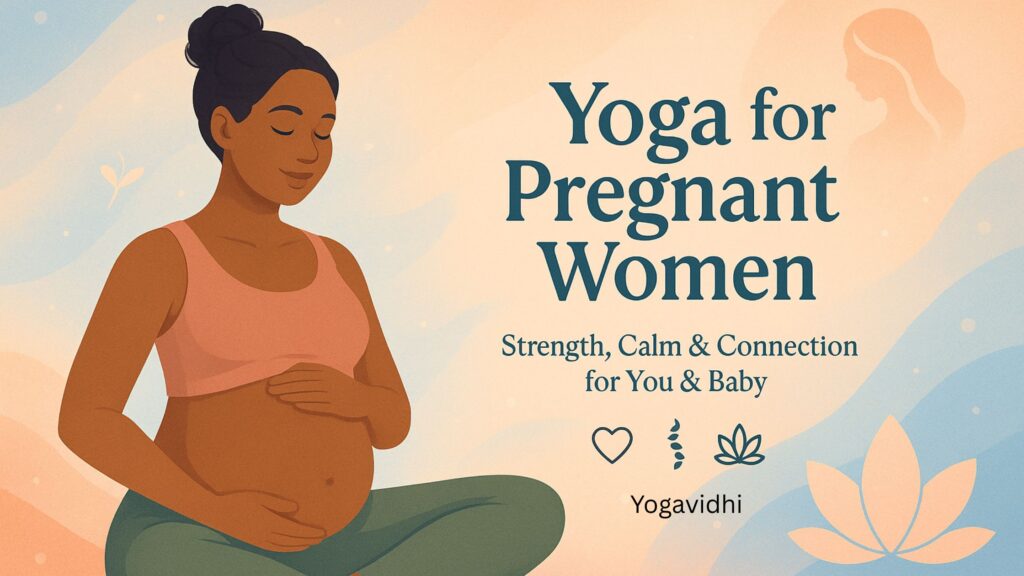Pregnancy is a beautiful and transformative journey—but it also comes with its fair share of physical discomfort and emotional ups and downs. As your body changes to support new life, it becomes crucial to find ways to stay grounded, strong, and serene. That’s where yoga for pregnant women comes in.
Far more than just a trend, prenatal yoga has become a trusted wellness practice recommended by healthcare providers, midwives, and mothers across the world. With a focus on breath, movement, and mindfulness, this gentle yet effective form of exercise can offer profound benefits throughout all stages of pregnancy.
Whether you’re a first-time mom or expecting your second or third baby, yoga during pregnancy can support your well-being in countless ways. Let’s explore how!
Yoga for pregnant women, commonly referred to as prenatal yoga, provides a wide range of physical and emotional benefits throughout pregnancy. It enhances flexibility, strength, and balance, while also helping to alleviate stress, anxiety, and back pain. The poses are carefully adapted to ensure safety and comfort for expectant mothers across all trimesters.
Table of Contents
What Is Prenatal Yoga?
Prenatal yoga is a style of yoga specifically designed to support the changing needs of pregnant women. It includes gentle postures, breathing techniques, meditation, and deep relaxation tailored to each trimester. Unlike more vigorous yoga styles, prenatal yoga focuses on safety, stability, and calming the nervous system.
The main goals of yoga for pregnant women are to:
- Strengthen the body for childbirth
- Promote flexibility in the hips and pelvis
- Reduce physical discomforts like back pain
- Improve breath awareness and stress relief
- Foster connection with the baby
By modifying traditional yoga poses, prenatal yoga offers a safe and empowering way to stay active and centered throughout pregnancy.
The Benefits of Yoga for Pregnant Women
Practicing yoga during pregnancy isn’t just about staying fit—it’s about creating a nurturing space for both mother and baby. Here are some of the top benefits:
1. Reduces Common Pregnancy Discomforts
Back pain, bloating, fatigue, and poor sleep are all common during pregnancy. Yoga for pregnant women helps stretch and strengthen key muscle groups, improving posture and circulation. Many women report less tension and more energy after just a few sessions.
2. Supports Mental and Emotional Well-being
Hormonal shifts and physical changes can affect your mood and stress levels. Yoga encourages mindfulness, deep breathing, and relaxation, all of which help manage anxiety and promote emotional balance.
3. Prepares the Body for Labor
Prenatal yoga teaches breathing techniques like ujjayi and nadi shodhana, which can be incredibly helpful during labor and delivery. Many poses also target the pelvic floor, hips, and legs—building strength and stamina for childbirth.
4. Encourages Bonding with Your Baby
Yoga gives you space to slow down, connect with your body, and tune into your baby. Visualization and guided meditations can foster a deeper sense of connection, love, and anticipation.
Safety Guidelines for Practicing Yoga While Pregnant
While yoga for pregnant women is generally safe, there are essential safety tips to keep in mind:
- Get medical clearance before beginning any prenatal yoga program.
- Avoid deep twists, backbends, or poses that compress the belly.
- After the first trimester, avoid lying flat on your back.
- Skip any hot yoga classes—excess heat can be dangerous.
- Always listen to your body and rest when needed.
- Use props like blocks, bolsters, and blankets for support.
The key is to focus on comfort, not intensity. Remember, pregnancy isn’t the time to push your limits—it’s a time to nurture yourself gently.
Best Yoga Poses for Pregnant Women (By Trimester)
Each trimester comes with different physical experiences. Here are trimester-specific yoga poses that are both safe and beneficial:
First Trimester (Weeks 1–13)
You may still feel like your usual self, but fatigue and nausea might creep in. Keep your practice light and gentle.
- Cat-Cow Pose (Marjaryasana-Bitilasana): Relieves lower back tension and promotes spinal mobility.
- Mountain Pose (Tadasana): Enhances posture and body awareness.
- Deep Breathing (Pranayama): Calms the nervous system and reduces morning sickness.
Second Trimester (Weeks 14–27)
This is often considered the most comfortable trimester. Your energy returns, and the baby bump starts to show.
- Warrior II (Virabhadrasana II): Builds strength and stamina in the legs and hips.
- Bound Angle Pose (Baddha Konasana): Opens the hips and prepares the body for birth.
- Side-Lying Savasana: A safe way to rest and relax.
Third Trimester (Weeks 28–40)
The body becomes heavier, and mobility decreases. Focus on comfort and breathing.
- Wide Child’s Pose (Balasana): Offers deep relaxation and hip opening.
- Pelvic Tilts: Helps relieve pressure on the lower back.
- Seated Forward Fold (with support): Encourages calm and introspection.
These poses are gentle and adapted for the growing belly—an essential part of any routine in yoga for pregnant women.
Yoga Poses to Avoid During Pregnancy
Certain poses and movements should be avoided to ensure your safety and your baby’s:
- Deep backbends (e.g., Wheel Pose)
- Inversions (e.g., Headstand)
- Lying on the stomach or back for prolonged periods
- Twists that compress the abdomen
- Hot yoga or Bikram yoga
Always err on the side of caution. A qualified prenatal yoga instructor will guide you on what’s appropriate.
Read More: Glow Yoga: Illuminate Your Body, Mind & Spirit
Read More: Daily Yoga: Transform Your Life One Pose at a Time
| Trimester | Recommended Yoga Poses | Benefits |
| First Trimester (Weeks 1–13) | – Cat-Cow Pose (Marjaryasana-Bitilasana) – Mountain Pose (Tadasana) – Deep Breathing (Pranayama) | – Relieves lower back tension – Enhances posture and balance – Reduces nausea and calms the nervous system |
| Second Trimester (Weeks 14–27) | – Warrior II (Virabhadrasana II) – Bound Angle Pose (Baddha Konasana) – Side-Lying Savasana | – Builds leg and hip strength – Opens hips and improves circulation – Promotes safe, supported relaxation |
| Third Trimester (Weeks 28–40) | – Wide Child’s Pose (Balasana) – Pelvic Tilts – Seated Forward Fold (with support) | – Eases pelvic pressure and lower back pain – Prepares pelvis for labor – Calms the mind and encourages introspection |
How to Choose the Right Prenatal Yoga Class
With so many yoga styles out there, finding the right class can be overwhelming. Here’s what to look for:
- Certified Prenatal Yoga Instructor: Ensure your teacher is trained in yoga for pregnant women and understands anatomy and trimester-specific needs.
- Small Class Size: A more intimate setting ensures personal attention.
- Supportive Environment: The right class will make you feel safe, seen, and supported.
You can also explore online prenatal yoga classes if going to a studio isn’t feasible. Platforms like YouTube offer excellent guided sessions.
Breathing Techniques & Meditation During Pregnancy
Breathwork is one of the most powerful tools in prenatal yoga. It helps manage stress, increases oxygen flow, and prepares you for the intensity of labor.
Try These Techniques:
- Deep Belly Breathing: Soothes anxiety and grounds the nervous system.
- Nadi Shodhana (Alternate Nostril Breathing): Balances the left and right hemispheres of the brain.
- Guided Meditation: Use visualizations to connect with your baby or release fear.
Including these practices regularly can make a huge difference in how you feel—emotionally and physically.
Tips for Practicing Yoga at Home During Pregnancy
Can’t make it to a class? No problem. Yoga for pregnant women at home can be just as effective with the right setup.
- Create a calming, quiet space with soft lighting.
- Use a yoga mat and props for comfort.
- Play soothing music or follow along with online videos.
- Set a routine—just 15–30 minutes a day can have big benefits.
Trust your intuition. If something doesn’t feel right, skip it.
What About After Delivery? A Peek into Postnatal Yoga
While this article focuses on yoga for pregnant women, it’s worth mentioning the benefits of postnatal yoga too. After delivery, your body will need time and care to recover.
Postnatal yoga can:
- Help restore core and pelvic floor strength
- Improve energy and mood
- Support bonding through baby-and-me yoga
Be sure to get medical clearance before resuming yoga postpartum.
Real Moms, Real Stories
“Yoga was my sanctuary during pregnancy. I was able to sleep better, breathe deeper, and feel confident going into labor. It was a game-changer.”
– Priya, 32, first-time mom
“Joining a prenatal yoga class helped me connect with other moms and made me feel less alone in my journey.”
– Meera, 29, expecting her second child

Conclusion: Embrace Your Journey with Yoga
Pregnancy is a unique and sacred experience—and with the help of yoga for pregnant women, it can be a more peaceful, empowered, and joyful one.
Whether you choose a prenatal yoga studio, follow online sessions, or practice in your living room, the benefits are profound. From easing physical discomforts to supporting emotional health and preparing you for labor, yoga offers the tools to thrive—not just survive—during pregnancy.
So roll out your mat, take a deep breath, and trust your body. You are strong. You are growing life. And yoga is here to support every step of that miracle.
Frequently Asked Questions:
Q. Is yoga safe for pregnant women in all trimesters?
Ans: Yes, with modifications and guidance from a trained prenatal yoga instructor, yoga can be safely practiced throughout all three trimesters.
Q. What are the best yoga poses for pregnant women with back pain?
Ans: Cat-Cow, supported Child’s Pose, and pelvic tilts are gentle yet effective for relieving lower back pain.
Q. Can beginners do yoga while pregnant?
Ans: Absolutely! Yoga for pregnant women is beginner-friendly and doesn’t require prior experience.
Q. How often should a pregnant woman do yoga?
Ans: 2–4 times a week is ideal, depending on your energy levels and trimester. Even short daily practices can be beneficial.
Q. Is yoga safe for pregnant women in all trimesters?
Ans: Yes, yoga is generally safe for pregnant women across all three trimesters—as long as it’s modified appropriately and practiced under guidance. Prenatal yoga is specifically designed to accommodate the physical and emotional changes that occur during pregnancy.
In the first trimester, gentle breathing, stretching, and relaxation help manage nausea and fatigue. During the second trimester, yoga supports strength, balance, and flexibility as your body adjusts to the growing baby. By the third trimester, the focus shifts to comfort, breath awareness, and preparing the body for labor.
To ensure safety:
• Avoid poses that compress the abdomen.
• Skip hot yoga or intense backbends.
• Always listen to your body and consult your doctor before beginning any new fitness routine.
Q. Which yoga is best for pregnancy?
Ans: Prenatal yoga, as well as hatha and restorative yoga, are widely regarded as safe and beneficial for pregnant women. These practices emphasize gentle movements, breathing techniques, and relaxation, which can help alleviate common pregnancy discomforts and support the body in preparing for childbirth. Recommended poses often include Tadasana, Virabhadrasana, Baddha Konasana, and the cat-cow stretch. However, it’s essential to consult a healthcare provider or a certified prenatal yoga instructor before beginning any new exercise routine during pregnancy to ensure it aligns with individual health needs and conditions.
Declaration Note:
We use third-party videos and images on https://yogavidhi.com/ for educational and illustrative purposes. All rights belong to their respective owners. No copyright infringement is intended.



